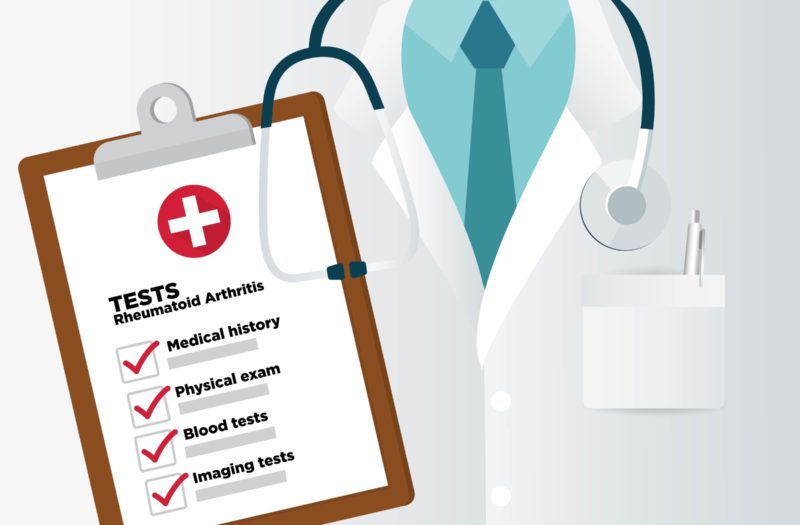Rheumatoid arthritis (RA) is a chronic autoimmune inflammatory disease that causes pain, swelling, and stiffness in your joints. Left untreated, it can result in permanent joint damage and may lead to many more health problems throughout your body. Diagnosing RA isn’t always easy, however. There’s no single test to confirm it, for one thing, and its early signs can mimic those of other disorders, such as lupus or psoriatic arthritis.
But identifying RA quickly — and getting the diagnosis right — is vital.
“It’s important to establish diagnosis of rheumatoid arthritis so that appropriate treatment may be initiated,” says Jonathan Kay, MD, professor of medicine and population & quantitative health sciences and the Timothy S. and Elaine L. Peterson Chair in Rheumatology at the University of Massachusetts Medical School in Worcester.
Starting treatment promptly can slow or even stop disease progression, explains Dr. Kay, preventing serious disability and preserving a good quality of life. “RA is a very treatable disease,” he says, “with many very effective therapies now available.”
If you or your doctor suspect that you might have RA, you should see a rheumatologist for a diagnosis as soon as you can. Here’s what you can expect of the process.
The Facts on Rheumatoid Arthritis
It is thought that up to 1.5 million American have rheumatoid arthritis. Its specific cause is unknown. The condition can strike at any age, though it often occurs between the ages of 30 and 60; risk increases as you grow older. Women are far more likely to develop RA than men. Smokers and people with a family history of RA have higher chances, as well.
Read more here about rheumatoid arthritis risk factors.
People with RA usually experience pain, swelling, stiffness and/or tenderness in multiple joints — most commonly the wrists, hands, and feet at first, though other joints can be affected. The symptoms are often symmetric, which means they occur in the same place on both sides of the body. Many patients will feel stiff for 30 minutes or more after they wake up in the morning.
In addition to inflamed joints, people with RA may experience a general “sick” feeling, including low fever, fatigue and anemia, or a shortage of healthy red blood cells. Eventually, patients may develop erosions of the joints, nodules under the skin, eye problems, and lung issues — among other complications — though these typically occur when RA isn’t controlled well. Having RA raises your risk for cardiovascular complications and certain cancers, such as lymphoma.
Since RA can be tough to distinguish from diseases with similar symptoms — especially early on — diagnosis is best done by a rheumatologist, an internal medicine doctor who specializes in diagnosing and treating musculoskeletal disease and systemic autoimmune conditions. The sooner, the better, as timely intervention can prevent life-altering problems from happening down the line.
The Diagnostic Criteria for Rheumatoid Arthritis
The diagnosis of rheumatoid arthritis can’t be established with just one test. Instead, rheumatologists rely on a combination of your medical history, a physical exam, laboratory tests, and sometimes imaging tests to pinpoint the disease.
They also try to rule out the possibility of other conditions that may resemble RA, such as lupus, psoriatic arthritis, gout, or osteoarthritis. This is called a differential diagnosis.
To begin the diagnostic process, a rheumatologist will take your medical history, which includes asking questions about your current symptoms — particularly pain, swelling, and stiffness —and their location, duration, and severity.
They’ll also ask about your family’s medical history as it pertains to RA and other autoimmune conditions. Conditions like RA can be more common in families with RA or other immune system-related health problems. For example, research recently published in the journal Arthritis Care & Research found that people who have a first-degree relative with RA are more than twice as likely as the general population to develop RA. A family history of lupus, scleroderma, thyroid disease, or inflammatory bowel disease (Crohn’s disease and ulcerative colitis) also substantially increased the risk of RA.
Your rheumatologist will also perform a physical examination, testing each of your joints for things like swelling, tenderness, and limited range of motion. The location of affected joints is important to diagnosis.
“On a physical exam, we’re looking for joint distribution or pattern of joint involvement,” says Tuhina Neogi, MD, PhD, professor of medicine and epidemiology at Boston University Schools of Medicine and Public Health, and chief of rheumatology at Boston Medical Center. “Rheumatoid arthritis can affect both small and large joints, and so it can affect many joints through the body — but the classic [presentation] is the small joints of the hands and feet.”
The greater the number of small joints involved, the more likely you are to have RA, though other inflammatory arthritis conditions can have similar patterns.
The affected joints can help rule out other diseases, as well. “The joints just below the fingernails — those joints are usually not involved in RA,” she explains. “So if we see involvement of those joints, we would think about other possible diagnoses.” These might include osteoarthritis and psoriatic arthritis, for example.
Tests That Help Diagnose RA
To help confirm or disprove RA, your rheumatologist will also have lab tests done. “The lab tests would point to likelihood of rheumatoid arthritis, as well as potentially rule out other possibilities on the differential diagnosis,” says Dr. Neogi. These tests may include:
Erythrocyte sedimentation rate (ESR) and C-reactive protein (CRP) blood tests detect and measure inflammation in your body. If inflammation levels are elevated, it helps build the case for an RA diagnosis. If inflammation levels are normal, says Dr. Neogi, “That might dissuade us from thinking about an inflammatory arthritis like rheumatoid arthritis, but would not rule it out.” Since inflammation is present in many diseases, these tests do not confirm whether you have RA by themselves.
Rheumatoid factor (RF) and anti-cyclic citrullinated peptide (anti-CCP) antibody blood tests look for proteins associated with RA. Testing positive for one increases your chances of RA diagnosis, while testing positive for both raises your odds even more. However, up to 50 percent of RA patients don’t have RF or anti-CCP antibodies. They are diagnosed based on other factors. In these cases, the RA is considered to be seronegative.
The possibility of some autoimmune disorders, such as lupus and Sjögren’s syndrome, can be eliminated with the help of an antinuclear antibody (ANA) blood test, while a synovial fluid analysis, which examines the fluid that lubricates your joints, can help count out gout by looking for crystals under the microscope.
Imaging tests like X-rays and ultrasounds can also help to diagnose RA — or rule it out — though they may not be necessary. “The presence of erosions on radiographs, which indicate the presence of joint destruction, may help to establish the diagnosis,” says Dr. Kay. However, doctors ideally want to establish and treat RA prior to that point, he says — before structural damage shows up in imaging.
Scans are valuable for another reason, though: to keep track of your RA over time. “Radiographs are useful as a baseline so that you can monitor disease progression — to see if people are developing bony erosions or other signs of joint damage and deformities,” Dr. Neogi explains.
Ruling Out Other Similar Conditions to RA
A major part of establishing RA is the differential diagnosis. Disorders with symptoms that may appear similar to RA include:
Viral polyarthritis
Certain diseases caused by viruses, including rubella, hepatitis B and C, and parvovirus, can cause acute swelling in multiple joints.
Reactive arthritis
Sometimes, bacterial infections elsewhere in the body may cause an immune response that results in an inflammatory arthritis that resembles RA.
Psoriatic arthritis (PsA)
Another form of inflammatory arthritis, PsA often occurs in people with psoriasis, known for causing scaly patches of skin called plaques — but not always. When there are no obvious skin problems, it may be difficult telling it apart from RA.
Lupus
While lupus, another autoimmune disease, can cause joint inflammation, it usually does not cause erosion of the bone.
Osteoarthritis
Sometimes this degenerative joint condition is mistaken for RA, especially when the joint pain affects the hands, and especially in middle-aged people and seniors.
Arthritis linked to inflammatory bowel disease or Lyme disease
Both conditions can trigger swelling in joints, like the knees.
Gout
This inflammatory arthritis can affect joints anywhere in the body, but most commonly occurs in the foot.
Palindromic rheumatism
This is a rare condition in which joints are inflamed for a little while, it goes away, and then it comes back again. Many people with palindromic rheumatism go on to develop RA.
The lab tests, physical exam, and medical history help to eliminate these conditions from consideration.
“Something like psoriatic arthritis or lupus could have a similar joint pattern,” says Dr. Neogi, “but this is where the history and looking for other features is important.” For example, both diseases often come with distinct skin symptoms. For lupus, it’s a butterfly-shaped rash across the face, and for PsA, it’s psoriatic skin rash like plaques. Seeing these would discourage a rheumatologist from making an RA diagnosis, even if joint inflammation symptoms are similar.
Diagnosing RA in ‘Outlier’ Patients
Some cases of RA may be different or more difficult to diagnose then others, and certain routine tests and exams might not be as helpful. These include patients with a very recent onset of disease, people whose RA is inactive, and those with seronegative RA.
In these situations, making an RA diagnosis may take more time, or more weight may be given to certain factors, but RA can still be accurately established.
In people with inactive RA, for example, a rheumatologist may rely less on CRP and ESR tests and more on RF and anti-CCP tests, as well as evidence of characteristic joint erosions on imaging, if the disease has been present for long enough to develop erosions.
The 2010 ACR/EULAR Classification Criteria Guidelines
Sometimes people who have been diagnosed with RA take part in studies or clinical trials —perhaps to try a promising drug or study ways to improve quality of life.
To identify RA patients with typical features of RA who are suitable for these important studies, scientists use a set of guidelines created by the American College of Rheumatology and the European League Against Rheumatism. These are called the 2010 ACR/EULAR classification criteria.
For classification purposes to be considered for enrollment into studies, patients must first have at least one inflamed joint that can’t be explained by another condition. Then they’re evaluated for classification based on the following:
- Joint involvement. Which joints are swollen? How many are affected? Are they large or small?
- Serology test results. What are the results of RF and/or ACPA tests?
- Acute-phase reactant test results. Are the results of CRP and/or ESR tests normal or abnormal?
- Duration of symptoms. Have symptoms been around more or less than six weeks?
Others who may be eligible for studies include long-time RA patients whose past symptoms fulfill the criteria, those with joint damage very characteristic of RA, and those with new RA who are receiving treatment.
Dr. Neogi, who co-authored the ACR/EULAR classification criteria, emphasizes they are not the same as diagnostic criteria. “Classification criteria are not used in diagnosis,” she explains. “Rather they identify the major common features of a condition that allows researchers to identify appropriate people to enroll into their studies.”
The Bottom Line
Whether you suspect you could have RA or are concerned that you may have been misdiagnosed with a similar condition, speak with your health care provider. They can refer you to a rheumatologist, who can get to the bottom of your symptoms.
“Having a diagnosis means that you can get started on appropriate treatment and prevent any sort of further worsening of the disease,” says Dr. Neogi. “The main aim is to manage symptoms, improve functioning, and offer people the ability to continue with the activities they enjoy doing.”
Not Sure What’s Causing Your Pain?
Check out PainSpot, our pain locator tool. Answer a few simple questions about what hurts and discover possible conditions that could be causing it. Start your PainSpot quiz.
Keep Reading
Aletaha D, et al. 2010 Rheumatoid Arthritis Classification Criteria. Arthritis & Rheumatism. September 2010. doi: http://dx.doi.org/10.1002/art.27584.
Diagnosis and differential diagnosis of rheumatoid arthritis. UpToDate. https://www.uptodate.com/contents/diagnosis-and-differential-diagnosis-of-rheumatoid-arthritis.
Diagnosis and management of rheumatoid arthritis. American Family Physician. December 2011. https://www.aafp.org/afp/2011/1201/p1245.html.
Interview with Jonathan Kay, MD, professor of medicine and population & quantitative health sciences and the Timothy S. and Elaine L. Peterson Chair in Rheumatology at the University of Massachusetts Medical School in Worcester.
Interview with Tuhina Neogi, MD, PhD, professor of medicine and epidemiology at Boston University Schools of Medicine and Public Health, and chief of rheumatology at Boston Medical Center
Kronzer VL, et al. Family history of rheumatologic, autoimmune, and non‐autoimmune diseases and risk of rheumatoid arthritis. Arthritis Care & Research. November 2019. doi: https://doi.org/10.1002/acr.24115.
RA Diagnosis: What Criteria are used to Diagnose Rheumatoid Arthritis? RheumatoidArthritis.org. https://www.rheumatoidarthritis.org/ra/diagnosis.
Rheumatoid Arthritis. American College of Rheumatology. https://www.rheumatology.org/I-Am-A/Patient-Caregiver/Diseases-Conditions/Rheumatoid-Arthritis.
Rheumatoid Arthritis (RA). Centers for Disease Control and Prevention. https://www.cdc.gov/arthritis/basics/rheumatoid-arthritis.html#risk.
Rheumatoid Arthritis. Mayo Clinic. https://www.mayoclinic.org/diseases-conditions/rheumatoid-arthritis/diagnosis-treatment/drc-20353653.
Rheumatoid Arthritis Clinical Presentation. Medscape. https://emedicine.medscape.com/article/331715-clinical#b6.
Synovial Fluid. MedlinePlus. U.S. National Library of Medicine. https://medlineplus.gov/ency/imagepages/19698.htm.






